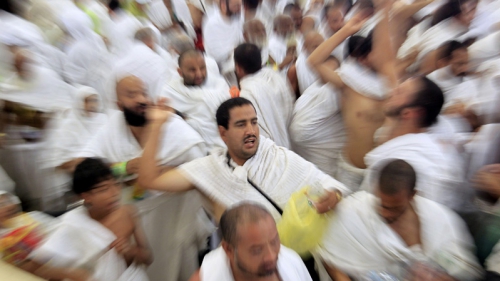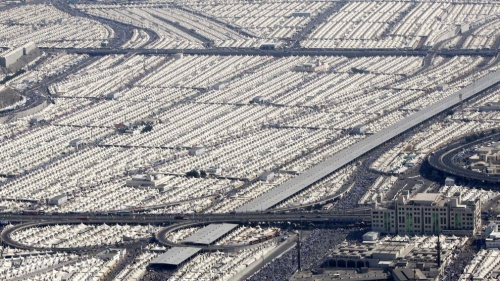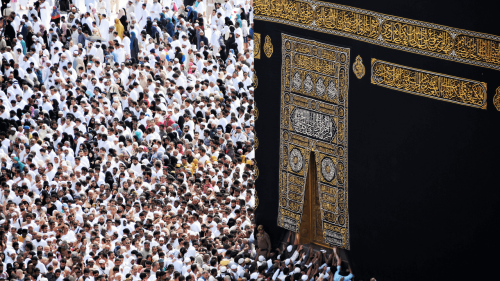Hajj Pilgrimage: Educating Colleagues and Students

Imran and Tasneem Carim decided in early 2010s, immediately after getting married, to perform Hajj together. Both completed the formalities with a local Muallim (Hajj guide) in Riverside county, southern California and also applied for extended leave at their place of work. Three months before Hajj, Imran, a Financial Advisor at a reputable Financial Company in California, left his job to seek a new job to pursue areas of his expertise. At a certain company during the interview he mentioned that if he is offered the job he would like the company to consider his personal situation, saying that he and his wife would like to fulfill their religious obligation and go to Hajj for which arrangements have already been made. He provided details about Hajj arrangements to the interviewers. Later the company offered him the job, took into account details he provided about Hajj and approved a three-week vacation in advance, to be applied to his vacation at one year anniversary on the job. This is one of the rear cases where a company approved vacation for Hajj even before offering the job. Tasneem Carim, who works as a teacher, also got three-week vacation for Hajj from the Public School.
At his new job, Imran talked to his colleagues two weeks before going for Hajj, providing details about Hajj and informing them that they should not be surprised to see him retuned from Hajj with his head shaven. The teachers at Tasneem’s Middle School and Imran’s colleagues were inquisitive about Hajj and wanted to hear details and see pictures of Hajj rituals.
After Imran and Tasneem returned from Hajj, Tasneem prepared a presentation titled, “23 Days on a Spiritual Journey of a Lifetime”. The presentation was customized by each one of them. Imran customized his presentation to address his financial company colleagues and also to show live Tawaf during umrah at the end of the presentation. Tasneem added different slides and tweaked her presentation for her audience, the 7th grade students, keeping in mind that in their history class these students had just finished studying the Unit on the Rise of Islam. This being an ongoing effort with the new students coming in 7th grade each year, Tasneem has shown her customized presentation more than 20 times so far.
At office, Imran started his presentation by making reference to the Hajj pilgrimage taken by Michael Abdul-Majid Wolfe, an American poet and a writer who related his Hajj experiences on the ABC Television Network in 2007.
Next, he talked about the five pillars of Islam and said that he and his wife Tasneem made a decision on their wedding day to go to Hajj. They joined a group from Riverside, California and embarked on a journey of the lifetime and travelled 8120 flying miles from Los Angeles to Dubai. At the Dubai airport they used the available facility, showered and changed into the Ihram clothes (White two-piece garment) prior to departing for Jeddah, Saudi Arabia. From Dubai they went to Jeddah by plane and travelled to Makkah by bus. While travelling from Jeddah to Makkah, they saw the highest part of a hill near Makkah where a clock tower appeared to be shooting outward towards the sky. It was a high rise building. When they arrived in Makkah they saw this building and were informed that this is the tallest hotel in the world that has world’s largest clock-face. This hotel is across from the Grand Mosque. Kaaba is located in the center of the Grand Mosque. The very first night they Performed “Umrah” -The Shorter, Extra Credit Pilgrimage. The ritual called Tawaf was performed as the first phase of Umrah that involved circling the Kaaba counter-clockwise seven times praying simple prayers from heart. To Muslims, circling the Kaaba represents the idea of Oneness, where everything revolves around it. This worship concept is taken from the order of the universe. The planets rotate around the sun, the electrons around the nucleus, moth around the candle; rotating around such a center, the Mosque build by Patriarch Ibrahim, the Kaaba, means showing allegiance with love to God, the creator of the universe.
The next thing he explained was the second ritual involved running and or walking back and forth seven times between two hills called Safa and Marwah, which are to the south and north of the Kaaba, in the footsteps of Hajra (Hagar), wife of Prophet Ibrahim, who had hastily run seven times between these two hills to see if she could spot water or anyone from whom she could get some water for her infant son, Ismail. It represents ‘turning’ towards God and not giving up on His mercy. Later Hagar found the well, now called Zam Zam Well.
After that Imran spoke about how five days later they went to Madinah, the city that gave refuge to Prophet Muhammad after he left Makkah. In Madinah he built the first Mosque which ranks as second most holy place after the Grand Mosque. Here Prophet Muhammad spent rest of his life and is buried along with his two companions - the first two Caliphs - Abubaker and Umar. They stayed in Madinah for five days and returned to Makkah to start the Hajj.
The next part of the presentation focused on the actual rites of Hajj. On the first day of Hajj they went from Makkah to Mina, a town approximately five miles from the Grand Mosque, and stayed in a tent where they spent the rest of the day.
On the 2nd day travelled from Mina to Arafat valley by train and stayed the whole day near Mount of Mercy in the plain of Arafat, spending time in praying and reflecting. They left Arafat valley after sunset, went to Muzdalifah and spent the night there and collected 21 stones for the pelting and stoning ceremony. In Muzdalifah performed evening prayer and spent the night on the ground beneath the open sky.
Then they directly proceeded to Mina before sunrise and stopped at the first stone monument called the Jamrat al Aqabah and threw seven consecutive pebbles to symbolize stoning the devil.
The 3rd, 4th and 5th day were spent in their assigned tent in Mina and also went to Jamarat to pelt Satan at Jamarat with stones collected at Muzdalifah. Stoning of Satan is done due for the following reasons: The Jamarat are three stone pillars that represent Satan. They are pelted, as a compulsory ritual of Hajj in emulating Prophet Ibrahim who pelted Satan with stones, when Satan tried to dissuade him from obeying the commands of Almighty God to sacrifice his son.
Imran then explained how he had all of the hairs on his head shaved as a sign of religious devotion and humility. Later, they went to Makkah and performed the final Tawaf around Kaabah and completed Sai, the ritual walking back and forth seven times between the hills of Safa and Marwah. These activities released them from the state of Ihram, allowing them to resume normal activities and wear regular clothes. Later, flew from Jeddah to Dubai, and a day later took a different flight and returned to Los Angeles.
At the end of his presentation, Imran switched his computer to live coverage of Tawaf around Kaaba in the Grand Mosque (Masjid al-Haram) at around 11:30 p.m. Saudi Arabia time, showing thousands of people performing Tawaf for their Umrah – the shorter pilgrimage. Imran said, “The Tawaf is performed 24/7 by people visiting from around the world.” All his colleagues were surprised and impressed because they had not seen anything like this before.
Tasneem prepared and customized the presentation with peripheral information being directed towards her audience, the 7th grade students. She started the presentation by saying, “This was not a like any vacation I’d taken before; been to New York and other places, but this is the special place. Who knows which place I was going to that I am talking about today? This is Kaabah in the center of the Grand Mosque. When we arrived in Jeddah, I was telling myself, ‘Are we really here?’ I mentally prepared myself for the experience & the lack of control I would have as a pilgrim on the events for the next three weeks.” Then she took the students on a ride with her for this sacred journey and said that the scenery during bus ride from Jeddah to Makkah felt like traveling back in time. She made the presentation understandable to students by the activities and the Hajj rituals performed each day.
She said that the Pilgrimage Umrah is made up of a series of rituals. Ritual # 1 – Tawaf: Circling the Kaaba 7 times; Ritual # 2 – Sa’i –Walking Between 2 hills, Safa and Marwah; Ritual # 3 – Drinking the “Zam Zam” Water; Ritual # 4 – Cutting or Shaving hairs. On the eighth day they travelled to Madinah and stayed in Madinah Movenpick Hotel; prayed in Madinah at the Prophet’s Mosque; visited historical places, and returned to Makkah on the 12th day to start the Hajj and stayed in an Apartment building. They spent 1st Day of Hajj in a tent in Mina (Day 15); 2nd Day of Hajj in Arafat Valley (Day 16), later went to Muzdalifah; 3rd, 4th & 5th Days of Hajj Stoning the Pillars in Mina (Days 17, 18, 19); Final Tawaf of Kaaba, Sa’i & Zam Zam water drinking (Day 20); Traveling to Dubai & back home in Los Angeles (Day 21-23).”
Tasneem’s presentation on Hajj and the pictures she shared with students helped them to bring alive the concepts of Islam the students were already learning in their history class. The other teachers who had asked Tasneem to come to their class and talk about Hajj thanked her for her efforts.
Mohammad Yacoob is a retired industrial engineer and engineering proposals analyst who lives in Los Angeles, California.

















